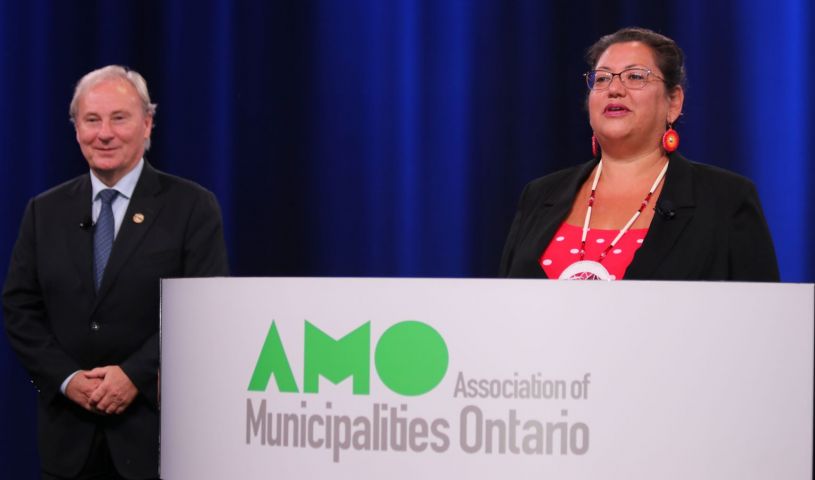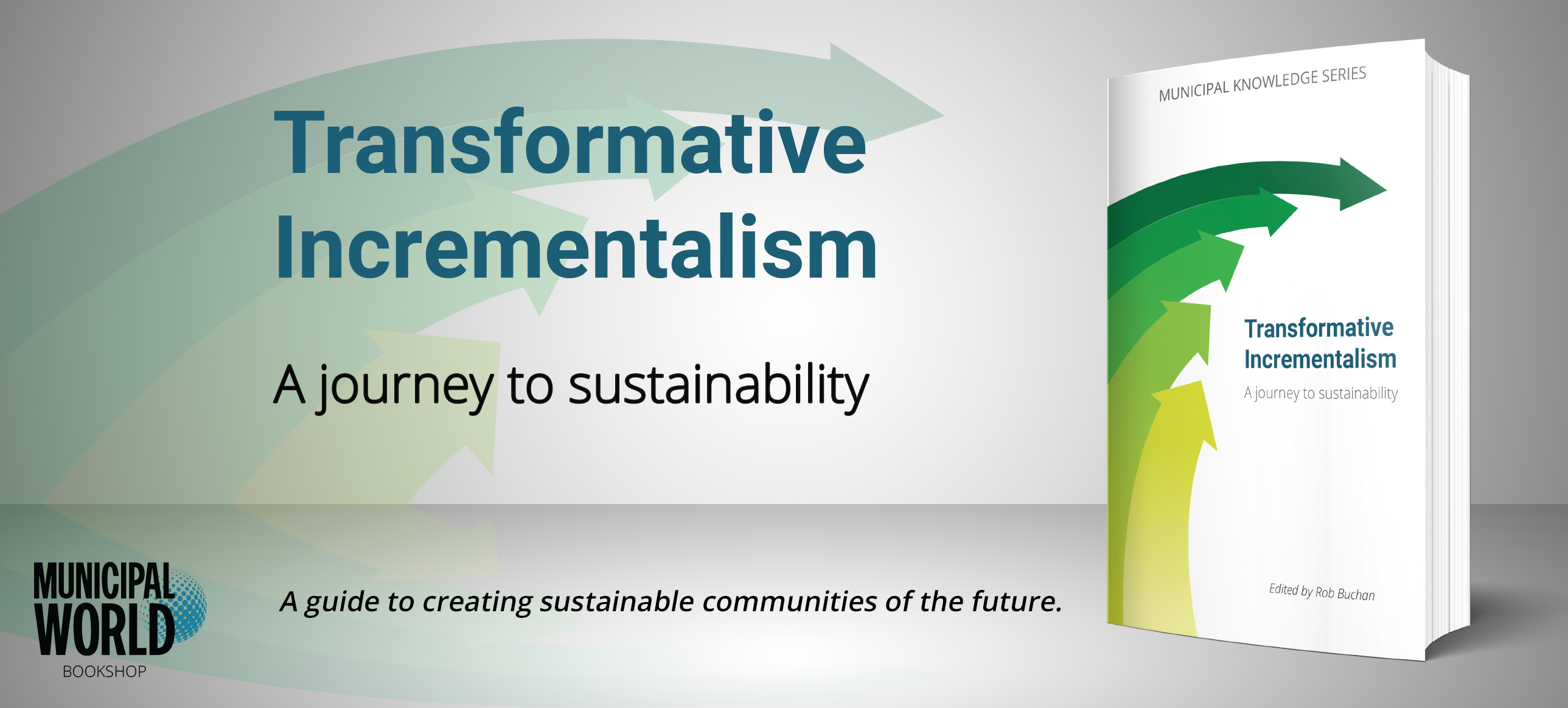Strengthening local Indigenous-municipal relationships
 Jennifer Dockstader, President of the Ontario Federation of Indigenous Friendship Centres, joined Jamie McGarvey, outgoing president of the Association of Municipalities of Ontario, as the two organizations sign a Declaration of Mutual Commitment and Friendship.
Jennifer Dockstader, President of the Ontario Federation of Indigenous Friendship Centres, joined Jamie McGarvey, outgoing president of the Association of Municipalities of Ontario, as the two organizations sign a Declaration of Mutual Commitment and Friendship.
“We really need to break down the barriers around who Indigenous people are,” says Jennifer Dockstader, President of the Ontario Federation of Indigenous Friendship Centres (OFIFC). “Are we actually working on issues of systemic racism and prejudice that exist, and bias? If so, talking about cultural competency is a natural place to start.”
Dockstader spoke recently as part of a panel at the of the Association of Municipalities of Ontario (AMO) annual conference that explored how municipalities can build stronger relationships with Indigenous people. Joining Dockstader on the panel were Shelly Hill, City of Hamilton Senior Project Manager, Urban Indigenous Strategy; and Doug Lawrance, Mayor of the Municipality of Sioux Lookout.
Roadblocks to Indigenous Political Engagement
One of the issues discussed in the panel was how municipalities can break down barriers Indigenous people face when it comes to elected positions.
Mayor Lawrance said that, in his community – which has a 50 percent Indigenous population – one obstacle is that many of those people come from their own First Nations and still feel more connected to those communities. They might be living in Sioux Lookout, but don’t engage in municipal politics.
There are proactive things that can be done, Mayor Lawrance said, such as appointing Indigenous people to committees. But, the issue is one of “generation to generation engagement,” which will take time to evolve.
For her part, however, Dockstader said she believes it is a lot more complicated than participation.
“I think that what is often misunderstood in Canada is that – I can speak about the Haudenosaunee – we do consider ourselves sovereign people. We do not consider ourselves Canadian citizens, so why would we run for elected office,” she said. “But then also, why is it if an Indigenous person does want to run for office, the average Canadian can’t see them as a viable candidate? Does that speak to systemic issues and how we need to break down the barriers of how we actually see Indigenous people?”
Starting Relationship-Building Conversations
The panel addressed how municipalities can get started on those important conversations.
Shelly Hill suggested that municipalities reach out to other communities to discuss where they are at, work they have done around Indigenous community development, and any kind of strategies they have in place. She was quick to add that AMO has put a lot of effort into supporting this work as well.
The need for municipal community cultural sensitivity training was also emphasized.
Hill said it is important to understand that cultural sensitivity training is key to developing any type of understanding of Indigenous people. This, she explained, requires looking at the “real truth” that things are done differently in the Indigenous community.
“We have our elders, our youth, every aspect of our life circle plays an important role in all the work that we do,” she said. “The cultural sensitivity training is a good step. It is important to take that training … but you need to continue it. You need to bring other events to the municipality, be more involved with what’s going on in the Indigenous community.”
Dockstader said the Ontario Federation of Indigenous Friendship Centres offers cultural competency training in phases. It’s very easy, she said, to reach out to them on their website to see how a municipality can go about bringing that effort into their community.
Investment in Affordable Housing is Priority One
Perhaps the most significant question in the discussion was around the “historic issues around the lack of funding for housing in First Nations,” which Mayor Lawrance called the biggest single challenge Sioux Lookout faces as a hub community for 30 First Nations communities.
People come to Sioux Looking for work, for education, for training, for health care, and for housing. And housing, he said, is being advocated for at every opportunity. In fact, even at the AMO conference the issue was put in front of both the Solicitor General and the Attorney General.
“The challenges we face in terms of mental health, addictions, homelessness, and corrections, we told the Solicitor General and the Attorney General, it all starts with housing,” the mayor said. “The solutions start with housing. We’ve had some success. We just need more of it. We need federal, provincial commitments to spend the money.”
Dockstader was quick to add that the issue is a lack of affordable housing stock and a lack of sustained commitments from the federal and provincial governments to actually build housing.
It is a systemic issue, she added, saying perhaps the question that needs to be asked is whether Canadians really believe that individuals are deserving – at the least – of having a roof over their head.
“People have to understand none of this happens in a vacuum. We have to look at the system issues,” she said. “It is a lack of housing, which leads to poor mental health, poorer health outcomes, poorer social determinants of health, which are a further financial drain on the system. We need to get that through to the average citizen that this is an investment worth making.”
Declaration of Mutual Commitment and Friendship
On the final day of the conference, Dockstader joined AMO’s outgoing president Jamie McGarvey to take another step toward reconciliation, signing the Declaration of Mutual Commitment and Friendship between OFIFC and AMO.
The declaration recognizes the work done by Friendship Centres and municipalities across the province in improving the quality of life of Indigenous people. Dockstader and McGarvey recognized the joint efforts of both AMO and OFIFC to strengthen Indigenous-municipal relations.
This work is particularly important, McGarvey said, given the fact 85 percent of Indigenous people live in urban and rural municipalities throughout Ontario.
“Friendship Centres and municipal governments have shown local leadership by establishing their own joint local declaration to fit their community and its needs,” he said. “Together, we are stronger. We encourage this work between municipalities and friendship centre to build strong relationships and improve community support centres.”
OFIFC represents the collective interests of 29 Friendship Centres in cities and towns across the province – places for community members and Indigenous people living in urban spaces to gather, connect with one another and receive culturally-based services. The centres support and encourage equal access to, and participation in, Canadian society while respecting Indigenous cultural distinctiveness, and have existed in Ontario communities for more than half a century.
Municipalities and Friendship Centres Sign Local Declarations
To date, a half-dozen Ontario municipalities and Friendship Centres have signed their own local declarations and others are in the works.
Dockstader said Friendship Centres recognize that the development of relationships based on mutual respect and trust with municipalities is essential to achieving long-term positive impacts on Indigenous communities and municipalities.
“By working together, Friendship Centres and municipalities are recognizing mutual responsibility to address urban Indigenous community needs through relationships, partnerships and collaboration.”
Both municipalities and Friendship Centres, she added, are uniquely positioned to improve wellbeing of Indigenous people by working to reduce inequality, discrimination, stigma, and racism – and by investing in improving social determinants of health.
“We hope this model becomes the model for collaboration across Ontario and beyond while we continue advancing reconciliation at the local level,” Dockstader said. MW
✯ Municipal World Insider and Executive Members: You might also be interested in Sean’s other article, Municipalities explore broadband barriers, possible solutions. Note that you can now access the complete collection of past articles (and more) from your membership dashboard.
Sean Meyer is Senior Content Editor for Municipal World. During his 25-year career in journalism, Sean has covered municipal politics in several small- and medium-sized communities and gained an understanding of the structure and political framework of government.
Related resource materials:



